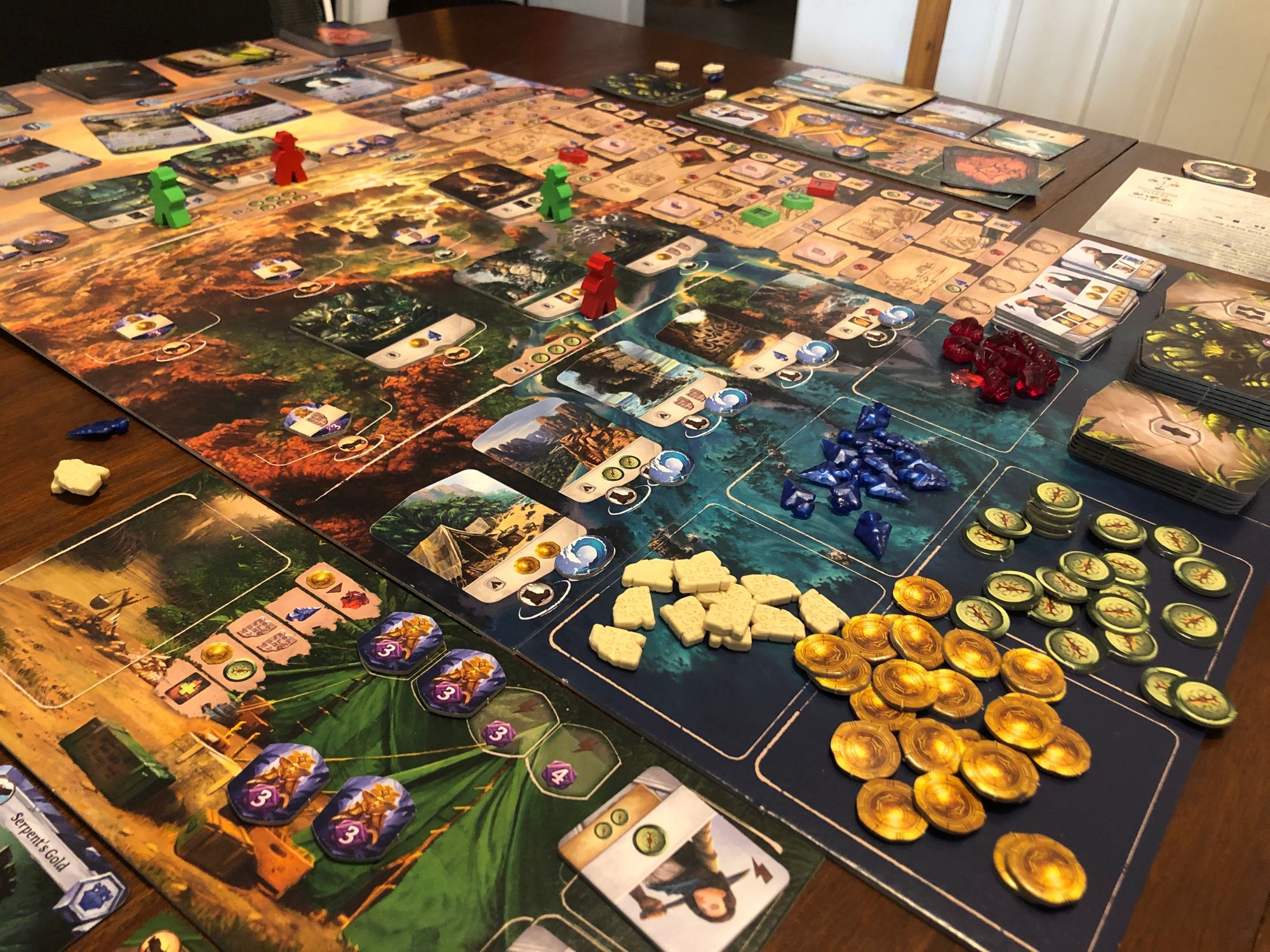Lost Ruins of Arnak has players exploring a mysterious island, fighting giant guardians, collecting powerful artifacts, and performing research into a lost, mystical civilization. It’s a great mix of deck building and worker placement, with a healthy bit of exploration and randomness for one to four players.
To set up, set out the large board and the resource board between all players. Shuffle the Artifact and Item decks and place them in their noted location at the top of the board. Stick the Fear cards face up between, then deal one artifact and four items in the round track below the decks. Stick the Moonstaff marker between the Artifact and the first Item; this will mark the current round. Then, place Discovery tokens on all of the exploration locations on the main board. Next, place victory point tokens at the top of the temple track, fill the temple track with bonus tiles, and place each player’s Magnifying Glass and Journal tokens at the bottom. Place Assistant tiles in three piles on the resource board along with piles of Resources and Exploration tiles. Give each player a player board, two Archaeologist meeples, and a deck of cards consisting of two Funding, two Exploration, and two Fear cards. Determine first player, draw five cards each (putting the remaining cards in a player’s draw area), and distribute initial Resource tokens based on player order.
To play, the active player can perform one of seven possible actions (along with any number of bonus actions). Digging at a site requires a player to pay a travel cost and place an Archaeologist at an unoccupied site, then collect the reward noted on the location. Travel costs are paid by placing cards matching value and quantity of travel icons noted at the dig site in the active player’s used card area. Travel icons include Planes, Boats, Cars, and Feet, and more significant methods of travel can be substituted for lesser ones. Initially, only the coastal dig sites are available, but as the game progresses and new areas are explored, new locations and richer rewards become available.
Discovering a site requires that the active player pays the noted travel cost of the location and then pays an additional amount of Exploration tokens as noted on the board (three or six, depending on the distance the location is from the shore). After paying the costs and placing an Archaeologist, the player collects the location icon and places it on their player board. They also immediately get the dig reward for the location. After revealing the reward, a location guardian is placed representing a barrier to future digs until it’s defeated.
Overcoming a guardian at a location where a player already has one of their Archaeologists requires a player to pay the resource cost noted on that guardian. When done, the guardian is removed from the board and placed on the overcoming player’s board for victory points at the end of the game. Thereafter, that site can be used as a dig site without having to pay the exploration cost (travel costs are still required).
Also, as an action, a player can purchase either an Artifact or Item card by paying the associated cost on its lower left corner. Items purchased are placed at the bottom of the player’s draw deck and won’t be used until they’re drawn. Artifact cards, however, are placed in the used card section of a player’s area and can immediately be used a single time. Once a card is purchased, it is replaced from the matching draw deck.
Item and Artifact cards in a player’s hand may have effects that require an entire action to perform (ones unmarked with a lightning bolt). Items and Artifacts are played down into the used card section of the active player’s area, and using an Artifact typically requires the spending of a Tablet token to perform.
Researching allows a player to move either their magnifying glass or journal token up the temple track. To perform this action, the active player must pay the resource cost noted between their current location and the room they wish to travel to. Once paid, a player moves either their Magnifying glass or their Journal (but the Journal can never pass the Magnifying glass token). If there is a reward token in the room, the first player to place a token there gets to claim it and the reward for reaching that level in the temple. Thereafter, players moving up to that level only receive the level reward.
Finally, players can pass when they decide they’re done with the round. Once passed, a player must wait for all other players to pass before taking another action. Once all players have passed, advance the round marker and adjust the item/artifact cards per the game rules, retrieve any Archaeologist meeples (earning a Fear card for any meeples pulled from a dig site with an active guardian), draw new cards (shuffling discarded cards as needed to get up to five cards in hand), rotate the first player marker, and resume play. Arnak consists of five rounds, and at the end, victory points earned from all of the various pathways are totaled. Most points wins.
Arnak is gorgeous. All components are beautifully illustrated, of significant quality, and have an extremely simple icon language to pick up. Tablets, arrowheads, and gem resources are acrylic and are just great to have. The board has two sides (for simple and advanced rules), tons of items, artifacts, and locations, and an extremely well-designed solo mode. It’s a great game that will see a lot of time at the table.
Designed by: Elwen, Min
Player Count: 1–4
Playtime: 30 minutes per player
Time to Learn: 15 minutes
Complexity: 3.5/5
Replayability: 5/5
MSRP: $60
Am I happy I bought it? Yes. I love games with a wealth of planning and options but streamlined methods of carrying those out, and Arnak definitely fits the bill.
Brendan Quinn is the President of Tri-City Area Gaming, a nonprofit dedicated to making games inclusive and accessible to everyone.
Find us at tricityareagaming.org and on Facebook: @TriCityAreaGaming.
Join us on Discord: discord.gg/gAgZzYz


